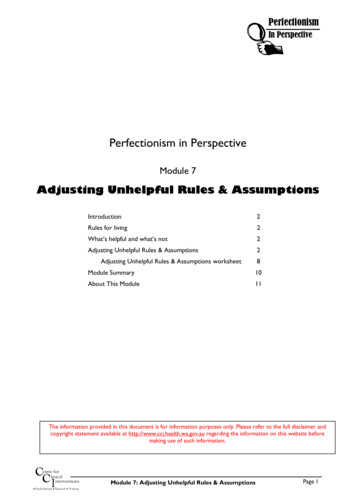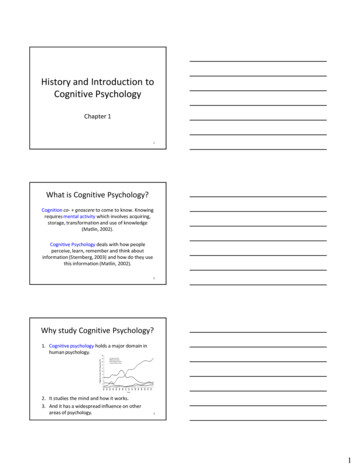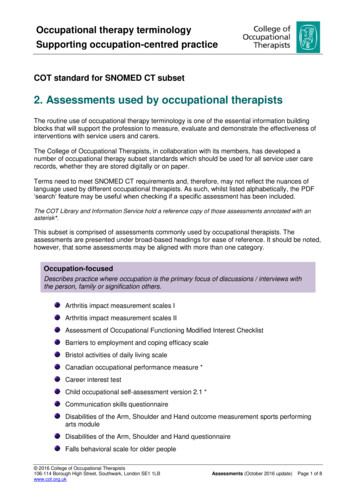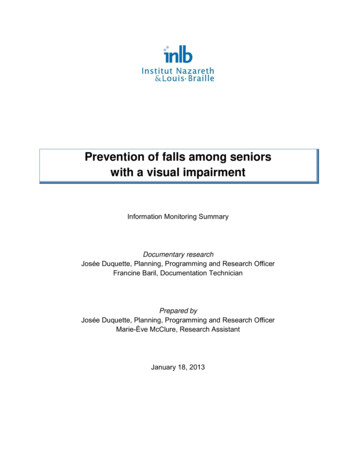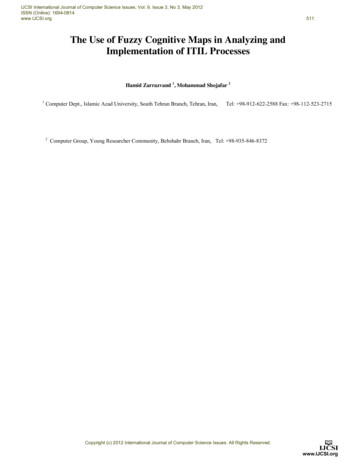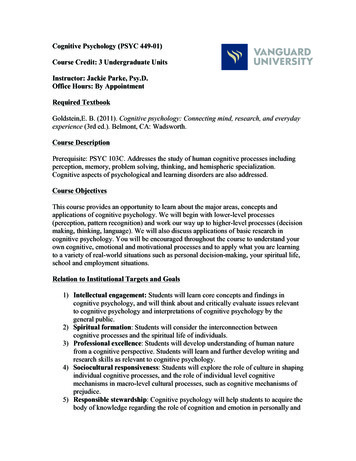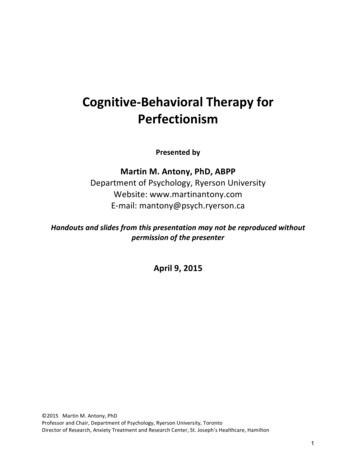
Transcription
Cognitive- UniversityWebsite:www.martinantony.comE- sionofthepresenterApril9,2015 ’sHealthcare,Hamilton1
Anxiety and Depression Association of AmericaCognitive-Behavioral Therapy forPerfectionismApril 9, 2015Martin M. Antony, PhD, ABPPProfessor and Chair, Department of Psychology,Ryerson University, TorontoDirector of Research, Anxiety Treatment andResearch Centre, St. Joseph’s Healthcare, Hamiltonwww.martinantony.comOutlineOverview of perfectionismCauses of perfectionismAssessment of perfectionismIntroduction to cognitive-behavioral therapyChanging perfectionistic thinkingChanging perfectionistic behaviorMindfulness and acceptance-basedapproaches§ Emerging research on treating perfectionism§ Recommended books and DVDs§ § § § § § § Definition of PerfectionismOVERVIEW OFPERFECTIONISMDefinition of Clinical Perfectionism“The overdependence of selfevaluation on the determined pursuit(and achievement) of self-imposed,personally demanding standards ofperformance in at least one salientdomain, despite the occurrence ofadverse consequences.”Perfectionism is a disposition toregard anything short of perfectionas unacceptableMerriam Webster DictionaryHistorical Perspectives§ “Tyranny of the shoulds” (Horney, 1950)§ “Musterbation” (Ellis & Harper, 1961)§ Normal vs. neurotic perfectionism(Hamacheck, 1978)Shafran, Cooper, & Fairburn, 20022
Perfectionismin the Context of OCPDExamples of Perfectionists§ A woman struggles to be a perfect parent, a perfect wife,and a perfect employee, often to the detriment of her ownemotional and physical health.§ A graphic artist constantly seeks reassurance that his workis of the highest quality, and that he is well respected andwell-liked by others.§ A student constantly strives to meet excessively highacademic standards, and who is devastated when shereceives a grade that is less than perfect.§ An individual spends hours planning every aspect of everyday, and who becomes very distressed when things don’tgo according to his plans.Egan, Wade, Shafran, & Antony, 2014“A pervasive pattern of preoccupationwith orderliness, perfectionism, andmental and interpersonal control, atthe expense of flexibility, openness,and efficiency”DSM-5 Definition of Obsessive-Compulsive Personality Disorder (OCPD)Obsessive-CompulsivePersonality Disorder§ Excessive concern with order, rules,lists, and trivial details§ Perfectionism that interferes with taskcompletion§ Excessively devoted to work (at theexpense of leisure, friendships)Domains of Perfectionism§ § § § § § § § § Performance at work or schoolRelationships, friendships and family lifeLeisure and recreationNeatness and aestheticsOrganization and orderingWritingSpeakingPhysical appearanceHealth and personal cleanlinessObsessive-CompulsivePersonality Disorder§ Overconscientious, inflexible aboutmatters of morality, ethics, values§ Unable to discard worn or objects§ Reluctance to delegate tasks to others§ Miserly§ Rigid and stubbornTransdiagnostic Nature of Perfectionism§ § § § § § § § § § Social and performance anxietyWorry and generalized anxiety disorderObsessive-compulsive disorderObsessive-compulsive personality disorderEating disordersBody dysmorphic disorderChronic fatigueProblem angerDepressionSuicidal ideationEgan et al., 20113
Pathways to PerfectionismCAUSES OFPERFECTIONISMLearning and Perfectionism1. Reinforcement of Perfectionism2. Modeling2. Other Learning Pathways§ Direct traumatic experiences§ Observational learning§ Informational/instructional learning§ § § § LearningCognitive factorsBiological factorsOther factors (e.g., stress, personality,interpersonal factors)ModelingFactors Affecting Modeling§ Attractiveness§ Similarity (e.g., values)§ Observing a model being rewarded fora particular behaviorAlbert BanduraCognitive View of Perfectionism§ Perfectionism stems from biased beliefs,assumptions, and predictions, for example:- Anything less than sticking to my diet perfectly is afailure. If I eat one cookie, I may as well have eaten tencookies.- I always need to look perfect in front of other people.- If I don’t get an A in this course, I don’t deserve to bein this program.- My reports are never good enough.- I seem to be the only person in this house who knowshow to clean things properly.Cognitive View of PerfectionismOther contributing factors include:§ Biased attributions§ Biased memory§ Biased attentionAdapted from Antony & Swinson, 20094
Cognitive Model of PerfectionismSelf-Worth Overly Dependenton Striving and AchievementCognitive BiasesInflexible StandardsPerformance-RelatedBehaviorsTemporarily MeetsStandardsFails to MeetStandardsAvoids Trying to MeetStandardsReappraise Standardsas InsufficientlyDemandingCognitive Biases§ Dichotomous (all-or-nothing / black and white)thinking§ Shoulds and musts§ Selective attention (noticing the negative;discounting the positive)§ Overgeneralization§ Double standardsCounterproductiveBehavior and SelfCriticismShafran, Egan, & Wade, 2010Performance-Related Behaviors§ Avoiding situations that may test one’sperformance (e.g., tests)§ Procrastination§ Goal achievement behaviors (e.g.,overpreparing)§ Testing one’s performance§ Reassurance seeking§ Social comparisonsAdapted from Egan, Wade, Shafran, & Antony, 2014Adapted from Egan, Wade, Shafran, & Antony, 2014Biology and PerfectionismGenetics Studies§ Disorders associated with perfectionism (e.g.,depression, anxiety disorder, eating disorders) aremoderately heritable.§ The trait of perfectionism has been found to bemoderately heritable (Moser et al., 2012; Tozzi et al.,2004).Neurotransmitters§ No studies in perfectionismBrain Imaging Studies (e.g., PET, fMRI)§ No studies in perfectionismPopular Perfectionism MeasuresASSESSMENT OFPERFECTIONISM§ Frost MultidimensionalPerfectionism Scale (Frost et al.,1990)§ Hewitt and Flett MultidimensionalPerfectionism Scale (Hewitt & Flett,1991)5
Frost MultidimensionalPerfectionism ScaleFrost MultidimensionalPerfectionism ScaleConcern over MistakesParental Expectations§ If I fail at work/school, I am a failure as a person.§ I hate being less than best at things.§ My parents set very high standards for me.§ My parents wanted me to be the best at everything.Personal StandardsParental Criticism§ I set higher goals than most people.§ As a child, I was punished for doing things less than perfectly.§ I am very good at focusing my efforts on attaining a goal.§ My parents never tried to understand my mistakes.Doubts about ActionsOrganization§ I usually have doubts about the simple everyday things I do.§ It takes me a long time to do something right.§ Organization is very important to me.§ I am a neat person.Hewitt and Flett MultidimensionalPerfectionism ScaleSelf-Oriented Perfectionism§ When I am working on something, I cannot relax until it is perfect.§ I demand nothing less than perfection of myself.Other-Oriented Perfectionism§ I seldom criticize my friends for accepting second best.§ The people who matter to me should never let me down.Socially Prescribed PerfectionismPositive and Negative PerfectionismMaladaptive Evaluative Concerns§ Hewitt & Flett MPS: SPP§ Frost et al MPS: CM, PE, PC, DAPositive Striving§ Hewitt & Flett MPS: SOP, OOP§ Frost et al MPS: PS, OR§ Those around me readily accept that I can mistakes too.§ My family expects me to be perfect.Bieling et al., 2004; Frost et al., 1993Questions to Determine WhetherStandards are Overly PerfectionisticQuestions to Determine WhetherStandards are Overly Perfectionistic§ Are my standards higher than those of otherpeople?§ Am I able to meet my standards? Do I getoverly upset if I don’t meet my ownstandards?§ Are other people able to meet mystandards? Do I get overly upset if othersdon’t meet my standards?§ Do my standards help me to achieve my goalsor do they get in the way (e.g., by making meoverly disappointed or angry when mystandards are not met; by making me get lesswork done, etc.)?§ What would be the costs of relaxing a particularstandard or ignoring a rule that I have?§ What would be the benefits of relaxing a specificstandard or ignoring a rule that I have?6
Evidence-Based StrategiesINTRODUCTION TOCOGNITIVEBEHAVIORALTHERAPYCognitive Strategies for Perfectionism§ Recalibrating cognitive biases, encouragingflexible thinking, and correcting unrealistic beliefsand interpretationsBehavioral Strategies for Perfectionism§ Exposure to feared objects, thoughts, situations§ Prevention of safety behaviorsOther Strategies (still unproven in perfectionism)§ Mindfulness and acceptance-based strategies§ Motivational enhancementEvidence-Based StrategiesStrategies for Targeting Associated Problems§ Social skills training (social anxiety disorder)§ Behavioral activation (depression)§ Progressive muscle relaxation (chronic worry)§ Medications (anxiety disorders, OCD, depression)Introducing the Treatment§ Understanding perfectionism (e.g., definitions,causes, features)§ Adaptive vs. maladaptive perfectionism§ Setting “SMART” goals (specific, measurable,attainable, relevant, time-bound)§ Readiness for treatment; beliefs about treatment§ Discussion of treatment expectations (number ofsessions, attending appointments, arriving on time,completing homework, ongoing assessment, etc.)§ Overview of treatment strategies§ Developing a collaborative CBT formulationTreatment Decisions§ § § § Group or individual?Number of sessions?Frequency of sessions?Focus on perfectionism vs. focus on one ormore specific disorders (e.g., depression,OCD)Sample 11-Session Protocol1. Motivational enhancement2. CBT formulation and monitoring3. Introduction to changing cognitive biases4. Introduction to changing maladaptive behaviors5. Introduction to behavioral experiments6. Maladaptive patterns of self-evaluation7. Rigidity, rules, and extreme standards8. Self-criticism and self-compassion9. Scheduling pleasant events10. Problem solving11. Relapse preventionAdapted from Egan, Wade, Shafran, & Antony, 20147
Homework GuidelinesAmount should be manageable and achievableInstructions should be unambiguousRationale should be clear to the clientLeave enough time to assign homeworkHomework should be planned collaborativelyEnsure clear expectation that homework will becompleted§ Begin each session with review of homework§ Avoid being punitive for failure to complete homework§ Homework is often progressive or additive§ § § § § § Adapted from Egan, Wade, Shafran, & Antony, 2014Homework Guidelines§ Some clients avoid homework (because itcannot be done well enough).§ Some clients do much more homework thanthey are asked to do (because they devaluesmall goals)§ It is helpful to work through beliefs thatclients may have about homeworkcompletionAdapted from Egan, Wade, Shafran, & Antony, 2014Components of Relapse Prevention§ Develop an action plan, emphasizing strategiesthat have been most helpful§ Discuss realistic and compassionate expectations§ Catch problems early§ Identify triggers for lapses and setbacks§ Strategies for dealing with lapses and setbacks§ Practice n, Wade, Shafran, & Antony, 2014Link Between Thoughts and Emotions§ It is 10 pm and two neighbors hear a loud bangoutside their houses. One neighbor feels angry,while the other neighbor feels scared. They haveboth heard the same noise, so what accounts forthem feeling differently?§ Two women arrive home to a bunch of flowersfrom their husbands with an attached note thatsays “I love you.” One woman immediately feelsworried, whereas the other one immediately feelshappy. What accounts for the difference in theirfeelings?Cognitive Strategies§ Designed to promote more flexible,adaptive, and realistic thinking.Egan, Wade, Shafran, & Antony, 20148
Perfectionism Myths§ The harder people work, the better they will do.§ To get ahead, you have to be single minded and giveup all outside interests.§ The more you put into something, the more you getout of it.§ People can’t be happy if they’re not successful.§ If I avoid it, it tends to sort itself out.§ If a job’s worth doing, then it’s worth doing right.§ People notice every little detail and are quick to formcritical judgments.Egan, Wade, Shafran, & Antony, 2014Changing Perfectionistic Thinking§ § § § § § § § Examining the evidenceEducationPerspective shiftingCompromising with self and othersBehavioral experimentsChanging social comparison habitsLooking at the big pictureTolerating uncertainty and ambiguityCognitive FeaturesAll-or-nothing thinkingUnrealistic and inflexible standardsRaising the bar when standards are metOverestimating likelihood of negativeevents§ Underestimating one’s ability to cope withnegative events§ Being overly focused on details§ § § § Using Emotional Shifts to Elicit ThoughtsQuestions to ask oneself§ What was going through my mind justbefore I started to feel this way?§ What was I saying to myself?§ What images did I have?§ What was I predicting would happen in thissituation?§ What does this say about me?Examining the EvidenceExamining the Evidence (continued)§ What facts, data, and experiences support mybeliefs, predictions or interpretation?§ Have I had any experiences to show that thisthought is not completely true all the time?§ If my best friend had this thought, what would Itell him or her?§ If someone who loved me knew I was thinkingthis thought, what would he or she say to me?§ When I am not feeling this way, does this sortof situation look different to me?§ Are there small things that contradict mythoughts that I might be discounting?§ Five years from now, as I look back on this,will I think about it any differently?§ Am I blaming myself for something overwhich I have no control?9
Identifying Double StandardsCognitive Reappraisal§ Pie Chart Technique§ Do I have one set of rules for myself, andanother set of rules for other people?§ Are the rules for myself harder than myrules for others?Egan, Wade, Shafran, & Antony, 2014Challenging Double Standards§ Is it fair to have harsher rules for myself than foreveryone else?§ What is the impact of holding a different set ofstandards for myself than for others?§ What would Isay to a friend who had a harder setof rules for him or herself than others?§ How does it follow that rules need to be harderfor myself than for other people?Identifying Should Statements§ What runs through my mind when I think ofthe “to do” list that I have to get through?§ How often do I say “should” and “must” toyourself when I am thinking of everything Ihave to do?Egan, Wade, Shafran, & Antony, 2014Egan, Wade, Shafran, & Antony, 2014Perfectionism Thought RecordChallenging Should Statements§ How does saying “should” to myself constantlymake mefeel? In what way does it impact on mysense of self?§ What impact might it have if I applied the sort ofpressure I apply on myself to a close friend?Egan, Wade, Shafran, & Antony, 2014EventBeliefsWhat was theWhat wentevent, situation, through my mind?thought, image or What does it saymemory?about me as aperson? Am Iusing unhelpfulthinking styles?Rate 0 - 100%!!!!!!!!!!!!!!!!!!!!Feelings BeforeDisputationFeelings AfterWhat was I feeling?What would afriend say?Is there anotherway of viewing thisthought?How do I feelnow?Rate 0 -100%!!!Egan, Wade, Shafran, & Antony (2014)10
Behavioral ExperimentsPerfectionism Thought RecordEventAt homeMondaynight lying inbed thinkingaboutpresentationthat I gave intheafternoonBeliefsFeelingsBeforeI said “um” a lot and stumbled Anxiousover my words at the start so (90%)the whole presentation wasruined (90%)(noticing the negative,discounting the positive)I screwed up thepresentation; I am such afailure; what a loser (90%)(labelling)I should be able to do a betterjob of presentations by now inmy career (80%) (shoulds)I may lose my job (60%)(catastrophizing)I know the audience wasbored as some people werelooking out of the window(80%) (mind-reading)DisputationJust because I stumbled over afew words does not mean thewhole thing was ruined; I wasmore confident after the start.FeelingsAfterAnxious(45%)No one said the presentationwas badJust because someone says“um” a lot in the first 5 minutesof a presentation does not makehim a failure as a personI would like to not be anxiousabout presentations, but tellingmyself to do better just makesme more anxiousThere is no evidence I will losemy jobI don’t know they were bored,they were probably thinkingabout other things§ Set up experiment to test out the validity of atarget cognition vs. an alternative cognition.May be a “real life” or simulated (role play)situation.§ Consider whether to disclose the expectedoutcomes or rationale to the client in advance.§ Report on the outcome (results).§ Reflect on the outcome and what conclusionscan be made.Egan, Wade, Shafran, & Antony (2014)Observational “Experiments”Behavioral ExperimentsExample§ Belief: I must always be busy. It is wrong not to bebusy. I could not tolerate being idle. Belief rating 100%.§ Alternative Belief: It’s okay to be idle sometimes.§ Experiment: Sit in a café for 20 minutes and reada newspaper.Egan, Wade, Shafran, & Antony, 2014§ Direct Observation: Observing others (e.g.,drawing attention to oneself), demonstrations,etc.§ Surveys: gathering a broad sample of factualinformation or opinions relevant to patient’sconcerns.§ Gathering Information From Other Sources:collecting factual information from reliablesources (i.e., certain internet sites, statistics,experts); demonstrations.(Bennett-Levy et al., 2010)Behavioral FeaturesCHANGINGPERFECTIOINISTICBEHAVIOR§ § § § § § § § § Overcompensating and overpreparingExcessive checking, reassurance seekingTrying to change the behavior of othersExcessive organizing and list makingNot knowing when to quitProcrastinatingAvoiding situations where with a risk of failingFailure to delegateAvoiding feared situations11
Changing Perfectionistic BehaviorSample In Vivo Exposures§ Take an aerobics class and work out infront of others§ Say something incorrect§ Spill a drink§ Talk about unfamiliar topics§ Ask for help in a store§ Drop something in front of others§ Make a mistake in public§ Ask for help§ Exposure to feared situations§ Preventing safety behaviors§ Setting priorities§ Preventing procrastinationPrinciples of Effective ExposurePredictability and perceived controlGraduated exposure versus floodingLonger exposure practices work bestExposures should be spaced closelyEliminate subtle avoidance strategiesVary the context of the exposurepractices§ Do not fight the fear§ § § § § § Abramowitz (2009)Sample Exposure HierarchyFear of Making Mistakes in Front of OthersItemAnxiety (0-100)Give a formal presentation about unfamiliarmaterial in front of people I don’t know well99Throw a party for people from work and preparean unfamiliar dish85Purposely forget my wallet when in line at the store85Ask someone to repeat themselves at a meeting75Show up for a haircut on the wrong day60Have lunch with a co-worker and allowuncomfortable silences50Forget my ticket when I pick up my dry cleaning40MINDFULNESS ANDACCEPTANCEBASEDAPPROACHES12
Definition of Mindfulness§ Deliberately paying attention toexperiences as they are, in thepresent and without evaluationAcceptance-Based Behavior Therapy§ Informed by ACT, MBCT, DBT, CBT§ Goal 1: Cultivate an expanded awareness anda compassionate and decentered stance towardinternal experiences§ Goal 2: Increase acceptance of (willingness tohave) internal experiences§ Goal 3: Encourage mindful engagement inpersonally meaningful behaviorsAcceptance-Based Treatments§ Dialectical behavior therapy§ Mindfulness-based stress reduction§ Mindfulness-based cognitive therapy§ Acceptance and commitment therapyAcceptance-Based Behavior TherapyRandomized Controlled Trial in GAD§ 81 Participants with generalizedanxiety disorder (GAD) randomlyassigned to 16 sessions of ABBT (n 40) or Applied Relaxation (n 41)Roemer, Orsillo, & Hayes-Skelton, 2012Roemer, Orsillo, & Hayes-Skelton, 2012Acceptance and MindfulnessBased Treatment for GADHamilton Anxiety Rating ScaleComponents of Treatment§ Psychoeducation§ Experiential exercises§ Between-session assignments (homework)§ Use of metaphorsEffects of ABBT and ARon Hamilton Anxiety Rating Scale252015Pre10Post6 Mo50ABBTARABBT Acceptance-based behavior therapyAR Applied relaxationRoemer et al., 2008Hamilton Anxiety Rating Scale, p .001Roemer et al., 201213
Effects of ABBT and ARon Quality of Life Inventory252015Pre10Post6 Mo50ABBTARABBT Acceptance-based behavior therapyAR Applied relaxation2.521.5PrePost16 Mo0.50ABBTARABBT Acceptance-based behavior therapyAR Applied relaxationBeck Depression Inventory, p .001Roemer et al., 2012Percentage of Participants AchievingClinically Significant Improvement% Clinically Significantly ImprovedQuality of Life InventoryBeck Depression InventoryEffects of ABBT and ARon Beck Depression InventoryABBT Acceptance-based behavior therapyAR Applied relaxation82807876Post746 Mo727068ABBTARClinically significantly improved within normative rangeon 3 of 5 anxiety measures (Newman et al., 2011)% Clinically Significantly Improved, p .001Quality of Life Inventory, p .001Roemer et al., 2012EMERGINGRESEARCHON TREATINGPERFECTIONISMRoemer et al., 2012Does Treatment Work? - Study 1§ N 107§ Diagnosis Social Anxiety Disorder§ Treatment 12 sessions of group CBT for socialphobia§ Ashbaugh, A., Antony, M.M., Liss, A.,Summerfeldt, L.J., McCabe, R.E., & Swinson, R.P.(2007). Changes in perfectionism followingcognitive-behavioral therapy of social phobia.Depression and Anxiety, 24, 169-177.Does Treatment Work? - Study 710.1715.88 .0001 .0001 .0001 .0001 .0001From: Ashbaugh, A., Antony, M.M., Liss, A., Summerfeldt, L.J., McCabe,R.E., & Swinson, R.P. (2007). Changes in perfectionism followingcognitive-behavioral therapy of social phobia. Depression and Anxiety, 24,169-177.14
MeasurePrePostpConcern over MistakesDoubts about ActionsPersonal StandardsParental ExpectationsParental CriticismOrganizationFMPS 22.0313.7111.1620.0185.90 .0001 .05n.s.n.s.n.s. .01 .01From: Ashbaugh, A., Antony, M.M., Liss, A., Summerfeldt, L.J.,McCabe, R.E., & Swinson, R.P. (2007). Changes in perfectionismfollowing cognitive-behavioral therapy of social phobia. Depression andAnxiety, 24, 169-177.Does Treatment Work? - Study 270CPE Score605040PrePost3020100ImmediateWaitlistRiley, C., Lee, M., Cooper, Z., Fairburn, C.G., & Shafran, R. (2007). A randomised controlledtrial of cognitive-behaviour therapy for clinical perfectionism: A preliminary study. BehaviourResearch and Therapy, 45, 2221-2231. CPE Clinical Perfectionism Examination.Does Treatment Work? - Study 3Results§ Generally, participants in both groupsshowed improvement on measures ofperfectionism, OCD symptoms,depression, and anxiety.§ Overall, improvement was greater in theGSH condition than the PSH condition§ Generally, gains were maintained at 3month follow-up.Does Treatment Work? - Study 2§ N 20§ Participants – high scorers on the ClinicalPerfectionism Examination and the ClinicalPerfectionism Questionnaire (Fairburn, Cooper, andShafran).§ CBT treatment vs. a wait-list control condition§ Treatment 10 sessions of individual CBT over 8 wks.§ Riley, C., Lee, M., Cooper, Z., Fairburn, C.G., & Shafran,R. (2007). A randomised controlled trial of cognitivebehaviour therapy for clinical perfectionism: A preliminarystudy. Behaviour Research and Therapy, 45, 2221-2231.Does Treatment Work? - Study 3§ N 49§ Participants – high scorers (84 or higher) on FrostMultidimensional Perfectionism Scale§ Guided self-help (eight 50-minute sessions) vs.pure self-help (no therapist)§ Treatment based on first edition of When PerfectIsn’t Good Enough (Antony & Swinson, 1998).§ Pleva, J., & Wade, T.D. (2006). Guided self-helpversus pure self-help for perfectionism: Arandomised controlled trial. Behaviour Researchand Therapy, 45, 849-861.Does Treatment Work? - Study 3% With Clinically Significant Change(pre-treatment to 3 mo. follow-up)Does Treatment Work? - Study 160504030GSHPSH20100CMPSDAPleva, J., & Wade, T.D. (2006). Guided self-help versus pure self-help for perfectionism:A randomised controlled trial. Behaviour Research and Therapy, 45, 849-861.GSH Guided Self-Help; PSH Pure Self-HelpCM Concern about Mistakes; PS Personal Standards; DA Doubts about Actions15
§ N 52§ Participants – high scorers (25 or higher) on theConcern over Mistakes subscale of the FrostMultidimensional Perfectionism Scale§ CBT for Perfectionism (n 18) vs. Online Self-HelpCBT for Perfectionism (n 16) vs. Waitlist (n 18)§ Treatment based on Overcoming Perfectionism(Shafran et al., 2010).Does Treatment Work? - Study 4% Recovered (based on CM Scores)Does Treatment Work? - Study 450454035302520151050Post-Tx6 Mo FUFace-to-FaceSelf-HelpWaitlistCM Concern about Mistakes (from the Frost Multidimensional Perfectionism Scale)Does Treatment Work? - Study 5§ N 42§ Participants – high scorers (25 or higher) on theConcern over Mistakes subscale of the FrostMultidimensional Perfectionism Scale§ CBT for Perfectionism (n 21) vs. Waitlist (n 21)§ Treatment included eight 2-hour group sessionsbased on Overcoming Perfectionism (Shafran etal., 2010).Egan et al. (2014). A randomized controlled trial of face to face versus pure onlineself-help cognitive-behavioural treatment for perfectionism. Behaviour Researchand Therapy, 63, 107-113.Does Treatment Work? - Study 5Concern Over Mistakes ScoresEgan et al. (2014). A randomized controlled trial of face to face versus pure onlineself-help cognitive-behavioural treatment for perfectionism. Behaviour Researchand Therapy, 63, roup CBTWaitlistResults maintained at 6-month follow-up.Handley et al. (2015). A randomized controlled trial of group cognitive-behaviouraltreatment for perfectionism. Behaviour Research and Therapy, 68, 37-47.Handley et al. (2015). A randomized controlled trial of group cognitive-behaviouraltreatment for perfectionism. Behaviour Research and Therapy, 68, 37-47.Perfectionism CBT Self- Help BooksRECOMMENDEDBOOKS AND DVDS§ Antony, M.M., & Swinson, R.P. (2009). When perfectisn’t good enough: Strategies for coping withperfectionism, second edition. Oakland, CA: NewHarbinger Publications.§ Shafran, R., Egan, S., & Wade, T. (2010). Overcomingperfectionism: A self-help guide using cognitivebehavioral techniques. London, UK: Constable &Robinson.16
Perfectionism Books for Professionals§ Egan, S.J., Wade, T.D., Shafran, R., &Antony, M.M. (2014). Cognitive-behavioraltreatment of perfectionism. New York,NY: Guilford Press.§ Flett, G.L., & Hewitt, P.L. (2002).Perfectionism: Theory, research, andtreatment. Washington, DC: AmericanPsychological Association.Perfectionism Treatment DVD§ Antony, M.M. (2008). Cognitive behavioraltherapy for perfectionism over time (DVDVideo). Washington, DC: AmericanPsychological Association.Other Perfectionism Books§ Burns, E.F. (2008). Nobody’s perfect: A story for childrenabout perfectionism. Washington, DC: magination press.§ Lavender, N.J., & Cavaiola, A.A. (2012). Impossible toplease: How to deal with perfectionist coworkers,controlling spouses, and other incredibly critical people.Oakland, CA: New Harbinger.§ Somov, P. (2010). Present perfect: A mindfulnessapproach to letting go of perfectionism and the need forcontrol. Oakland, CA: New Harbinger Publications.17
18What went through mymind? What does it sayabout me as a person?Am I using unhelpfulthinking styles? Rate 0- 100%What was the event,situation, thought,image or memory?BeliefsEventHow do I feel now?Feelings AfterEgan, Wade, Shafran, & Antony (2014)What would a friend say?Is there another way ofviewing this thought?What was I feeling?Rate 0 -100%DisputationFeelings BeforePerfectionism Thought Record
Recent Books by the Presenter1.Egan, S.J., Wade, T.D., Shafran, R., & Antony, M.M. (in press). Cognitive-behavioral treatment ofperfectionism. New York, NY: Guilford Press. To be published September 2014.2.Antony, M.M., & Roemer, L. (2011). Behavior therapy. Washington, DC: American PsychologicalAssociation. ISBN: 978-1-43380-984-2.3.Owens, K.M.B., & Antony, M.M. (2011). Overcoming health anxiety: Letting go of your fear of illness.Oakland, CA: New Harbinger Publications. ISBN: 978-1-57224-838-0.4.Antony, M.M., & Barlow, D.H. (Eds.) (2010). Handbook of assessment and treatment planning forpsychological disorders, 2nd ed. New York, NY: Guilford Press. ISBN: 978-1-60623-868-4.5.Antony, M.M., & Norton, P.J. (2009). The anti-anxiety workbook: Proven strategies to overcome worry,phobias, panic, and obsessions. New York, NY: Guilford Press. ISBN: 978-1-59385-993-0.6.Antony, M.M., & Stein, M.B. (2009). Oxford handbook of anxiety and related disorders. New York, NY:Oxford University Press. ISBN: 978-0-19530-703-0.7.Antony, M.M., & Swinson, R.P. (2009). When perfect isn’t good enough: Strategies for coping withperfectionism, 2nd edition. Oakland, CA: New Harbinger Publications. ISBN: 978-1-57224-559-4.8.Antony, M.M., & Rowa, K. (2008). Social anxiety disorder: Psychological approaches to assessment andtreatment. Cambridge, MA: Hogrefe. ISBN: 978-0-88937-311-2.9.Antony, M.M., & Swinson, R.P. (2008). Shyness and social anxiety workbook: Proven, step-by-steptechniques for overcoming your fear, 2nd edition. Oakland, CA: New Ha
Apr 09, 2015 · Recommended books and DVDs OVERVIEW OF PERFECTIONISM Definition of Perfectionism Perfectionism is a disposition to regard anything short of perfection . (OCPD) Obsessive-Compulsive Personality Disorder ! Excessive concern with order, rules, lists, and
